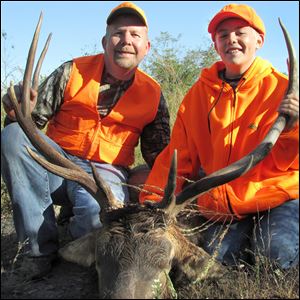
OUTDOORS
Lottery lets youth display hunting skills
10/14/2013
Matt Markey.

Mark Armbruster of Wood County and his son, Ben, 12, pose with a 5 by 5 bull elk Ben harvested while hunting in southeastern Kentucky last week.

Matt Markey.
There was only one out-of-state hunter whose name was drawn in the lottery for this season’s Kentucky youth elk hunt — and that was Ben Armbruster. Winning the lottery has a lot to do with luck.
The fact Ben came home to Ohio last week with a trophy 5-by-5 bull elk — there wasn’t a lick of luck involved in that. It was the result of skill, determination, patience, resolve, and a surprisingly steely set of nerves — all packaged in a 12-year-old.
There aren’t many kids Ben’s age who have had the opportunity to hunt elk, and precious few have done it successfully. You can count the elk hunters at Elmwood Middle School on your index finger — one — Ben Armbruster.
His dad Mark had entered the lottery numerous times, hoping to land a Kentucky elk hunt permit, but had never been successful in securing one of the precious few that go to nonresidents. He entered again early this year, and decided to put his son’s name in for the youth hunt, knowing it was more than a long shot. When the results were posted online in May, there was one non-Kentuckian in the youth hunt — Ben.
“It was total shock,” Mark Armbruster said about his reaction.
Some furious research followed as dad contacted guides, elk experts from around the country, and anyone else with knowledge of the terrain, the techniques, and the topography.
“It’s a lot different than how we hunt deer,” said Ben, who took his first and only whitetail buck with a crossbow at age 10, hunting from a tree stand.
When it came time to select a hunting area, father and son chose the Hazard region, where reclaimed strip mine lands have morphed into rugged and productive elk habitat. Elk are native to Kentucky, but the population was wiped out sometime in the 19th century. A restocking program that started in 1997 created a 16-county elk restoration zone, and with abundant food sources, mild winters, and the absence of predators, the elk herd has thrived and expanded significantly, and is now estimated to be in excess of 10,000 animals.
The Armbrusters traveled to Hazard about 10 days ago, and after a tough weekend that featured temperatures in the upper eighties and very little elk activity, things picked up when the weather cooled, as the marathon days of predawn to postdusk spent in the Appalachian woods continued.
“On Tuesday, the bulls were moving around and bugling like crazy,” Mark Armbruster said. “They were just screaming everywhere — it was awesome. We could not believe how many elk were in the area.”
Working with a local guide, the Armbrusters located several bulls by first light. Ben had passed up a shot at a smaller bull earlier in the hunt, and now was tracking a husky 5-by-5 (number of points on each antler).
To minimize the noise they made moving through the woods, Ben and the guide split from the rest of the hunting party and moved ahead, but the big bull spooked twice.
“We followed this one for a half mile or so, and as we were following it, he was bugling loud, so we knew he was close,” Ben said. “We could hear him coming through the brush.”
When the bull elk stepped out onto an overgrown two-track, about 110 yards away, Ben shouldered his rifle and fired. One shot dropped the bull at about 8 a.m.
“It all happened so quick, there wasn’t really any time to be nervous,” Ben said. “It was probably only five seconds from the time I saw him, until I fired.”
Ben shot the elk about a mile from where his dad had parked their truck early that morning, and although it took about three hours to get the 650-pound elk to the truck and for Mark to quarter it, the excitement of the moment didn’t wane.
“I was probably 100 yards back when I heard the shot,” Mark said. “I didn’t see it, but the guide told me Ben performed like a pro. He was as cold as ice when that moment came. Of course, his dad was very happy for him.”
The pair loaded the back of the pickup with ice, returned to the hotel long enough to clean up, and then hit the road for the return trip to Ohio.
The meat is now in the freezer, the elk rack is at the taxidermist’s, and Ben is back in school.
“I guess it couldn’t have worked out much better, with him getting drawn in the lottery, and then taking a really nice bull on his first elk hunt,” dad Mark said.
“He didn’t say much when I got up to where the elk was, but he was all smiles. It was a super cool father and son moment — probably one of the best we’ve had. I’m just so proud of the way he handled everything.”
TURKEY SEASON: Ohio’s fall turkey season opened on Monday and runs through December 1. Eight new counties, including Seneca and Huron, were recently added to the group that are open for the seven week season, bringing the total to 56 Ohio counties. The ODNR estimates the wild turkey population in the state to be about 180,000 birds. Details on the season, hunting hours, and game-check procedure are available at wildohio.com.
SWANS SHOT: Several trumpeter swans were reportedly shot over the weekend near Castalia, with two of the rare birds killed and one injured, according to accounts of the incident. Sandusky County Wildlife Officer Brian Bury reportedly identified a duck hunter as being responsible for shooting the swans, which are officially listed as a “threatened species” and off-limits to hunting. If found guilty, the responsible party could face thousands of dollars in fines. The injured swan is reportedly being cared for at an area wildlife rehabilitation facility.
Contact Blade outdoors editor Matt Markey at: mmarkey@theblade.com or 419-724-6068.